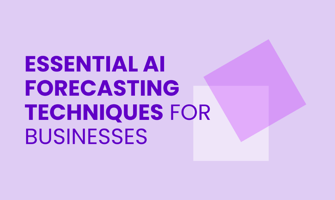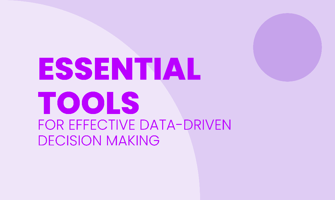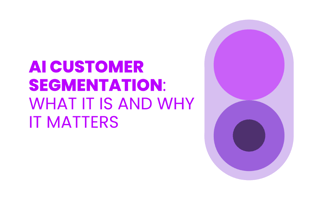Unexpected market changes, shifting customer demands, and financial risks make business planning...
Enhancing Decision-Making with AI: 5 Examples of How AI is Used in DDDM
Decision-making is a critical aspect in various fields, from business to healthcare. It's the process of choosing the best course of action among several alternatives.
In recent years, we've seen an increased importance of AI in data-driven decision-making (DDDM). The ability to analyze large volumes of data quickly and accurately gives AI a distinct advantage over traditional methods. This article provides five key examples demonstrating how AI enhances decision-making.
In 2025, Gartner predicts that 95% of decisions that currently use data will be at least partially automated.
The Increasing Importance of Artificial Intelligence in the Decision-Making Processes
Data has become a significant factor in making decisions. It's not just about gut feelings or experience anymore, but solid facts backed by numbers. AI can process and analyze large datasets quickly and efficiently. But it's not just about speed; accuracy is also a key advantage of AI.
One fascinating aspect of AI is its capability to uncover hidden patterns within data. These could easily be missed by human analysis due to their complexity or subtlety. These insights can provide valuable input for strategic planning, helping organizations make informed decisions that align with their goals and objectives.
Moreover, operational efficiency can significantly improve when incorporating AI into decision-making processes. By automating routine tasks and providing accurate predictions, resources can be allocated more effectively leading to better outcomes overall.
Here are some examples of how AI can be utilized for decision-making:
1. Predictive Analytics
Predictive analytics is a branch of advanced analytics that uses historical data, statistical algorithms, and machine learning techniques to identify the likelihood of future outcomes based on input data. It's all about providing the best available assessment of what will happen in the future, so organizations can feel more confident that they're making the best possible business decision.
Forecasting
Artificial intelligence plays an essential role in predictive analytics by automating complex processes for analyzing large datasets. This not only saves time but also uncovers insights humans might miss. For instance, let's consider the retail industry as an example.
Retailers use AI-driven predictive analytics to forecast demand for their products accurately. By examining past sales data and considering factors like seasonality or promotional events, AI can predict which items are likely to sell out quickly or stay on shelves longer than desired.
This kind of accurate forecasting has numerous applications and benefits across various industries such as healthcare where it helps in predicting disease outbreaks. In finance, it aids in identifying potential investment opportunities, and in sports, it assists teams in strategizing their game plans based on predicted player performance.
Risk Control
Risk assessment is another area where predictive analytics shines brightly with artificial intelligence at its core.
By identifying patterns from past incidents and current conditions, AI systems can anticipate potential risks before they become problematic. Be it financial risks for businesses or health risks for patients under medical care, proactive risk management powered by AI helps avoid negative outcomes. It also enables organizations to prepare better contingency plans which ensures smooth operations regardless of unforeseen circumstances.
Integrating artificial intelligence into your predictive analytic tools could prove beneficial for making informed strategic decisions or trying to mitigate potential risks ahead of time.
2. Recommendation Systems
Artificial intelligence can process massive amounts of data, including customer behavior and preferences. This valuable information is then used to create detailed profiles that significantly improve marketing strategies.
Customer Insights
AI plays an important role in analyzing customer data. It creates comprehensive profiles based on a person's behavior and preferences. Understanding these patterns leads to more effective marketing strategies as you can tailor your approach according to what each segment of your audience prefers.
Personalized Recommendations
Beyond just understanding customer behaviors, AI takes it a step further by providing personalized product or service recommendations. This personal touch not only improves the overall user experience but also fosters loyalty among customers because they feel valued and understood. Various sectors have started leveraging this feature of AI to enhance their competitiveness.
3. Natural Language Processing (NLP)
Predictive Analytics and Future Forecasts
Natural language processing, or NLP for short, is a branch of artificial intelligence that gives machines the ability to read and understand human language. A promising development in AI technology, NLP makes it possible for computers to hear speech, read text, interpret it, measure sentiment, and determine which parts are important.
Data Analysis
Today's businesses generate vast amounts of textual data from various sources like customer emails, chat logs, social media posts, and more. Analyzing this text can reveal insights about customer preferences and behavior. However, going through such large volumes manually would be time-consuming and require many skilled professionals.
NLP allows systems to process large amounts of natural language data efficiently thereby aiding decision-making processes significantly. For instance, with the help of NLP algorithms, we can quickly analyze feedback from customers across all platforms - identifying common trends or issues they might be facing with your product or service.
Customer interaction
When it comes to enhancing user interaction, AI-powered virtual assistants and chatbots employ NLP to interact with users naturally and instantly answer their queries accurately. This is beyond human capabilities considering the volume at hand.
Integrating natural language processing into your operations is important whether you're trying to obtain insights from massive data sets or improve customer experience with instant responses.
4. Automation and Optimization
Automation and optimization are two key areas where artificial intelligence (AI) has made a significant impact.
Automation
AI can automate routine decision-making tasks, which were previously handled by humans.
This means that tasks like data entry or report generation can now be done faster and more accurately by AI systems. By automating these tasks, human resources are freed up to focus on strategic decisions that require human intuition and creativity.
For example, in the manufacturing industry, AI is used to automate quality control processes. Machines equipped with cameras and AI algorithms inspect products for defects at a speed much faster than any human could achieve.
5. Decision Support Systems
Decision support systems, powered by artificial intelligence, are becoming increasingly prevalent in various industries. These systems offer real-time feedback and recommendations that can significantly improve the decision-making process.
Instant Feedback
AI-based decisions are known for their speed and accuracy. The ability of AI to provide instant feedback is a game-changer for many organizations.
It allows them to quickly adjust to changing conditions or new information. For instance, an online retailer might use AI to adjust pricing strategies based on real-time demand data.
Scenario Analysis
Scenario analysis is another area where AI shines brightly. Simulating different scenarios and their potential outcomes aids strategic planning and informed decision-making processes immensely. An example could be a logistics company using AI to simulate various delivery routes under different weather conditions.
Conclusion
AI speeds up the process of data-driven decision-making by processing large amounts of data in a short time. This not only makes the whole DDDM process quick but also more accurate.
Therefore it's crucial for organizations looking to stay competitive to consider integrating artificial intelligence into their operations if they haven't already done so.
This isn't just about keeping up with technology trends, it's also about making informed decisions that drive success.
FAQ
How does Artificial Intelligence inform decision-making in data-driven processes?
AI enhances decision-making in data-driven processes by analyzing large volumes of data quickly, identifying patterns and trends, and providing valuable insights for informed decision-making.
For example, AI algorithms can predict customer purchasing behavior based on previous interactions, allowing businesses to tailor their marketing strategies accordingly.
What are some of the impacts of Artificial Intelligence on data-driven decision-making?
AI helps in identifying patterns, forecasting trends, recommending actions, and automating decision-making processes. For example, AI can analyze large data sets to predict customer behavior, optimize marketing strategies, and enhance operational efficiency.
How can organizations make better AI-based decisions based on data analysis?
AI can help organizations make better decisions by analyzing large amounts of data quickly and accurately, leading to actionable insights. For example, AI can predict customer behavior, optimize supply chains, and identify trends for informed decision-making.
How does AI contribute to the democratization of decision-making?
AI contributes to the democratization of decision-making by making advanced decision-making tools accessible to a broader range of organizations, regardless of size or resources. AI-powered tools and platforms are becoming more user-friendly and affordable, allowing smaller organizations to leverage data-driven insights that were once only available to large enterprises.
What challenges can an enterprise face when implementing Artificial intelligence in their decision-making processes?
Some challenges organizations may face when implementing AI in decision-making processes include data privacy concerns, lack of skilled personnel, bias in algorithms, and difficulty in interpreting AI recommendations. For example, ensuring that AI models comply with regulations like GDPR can be a significant hurdle.




